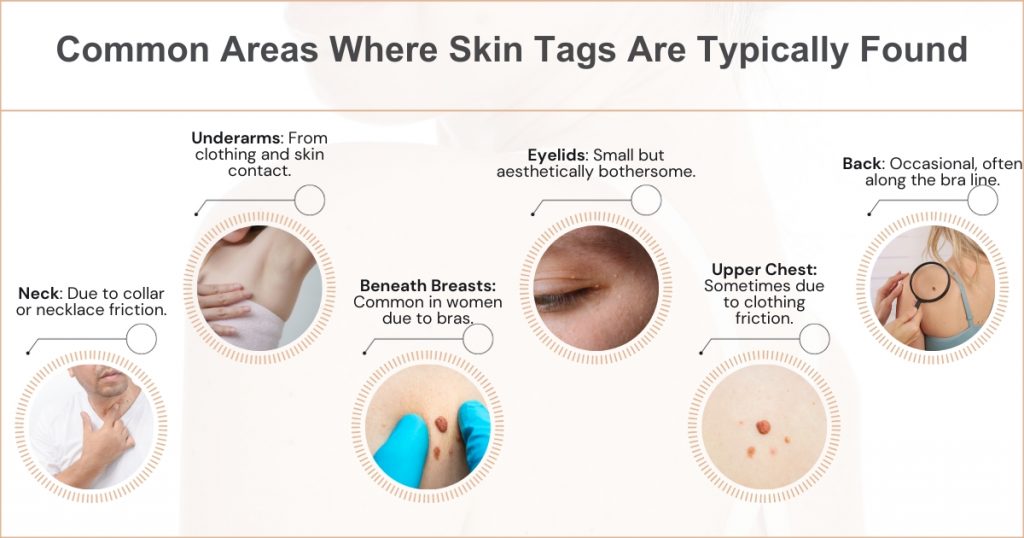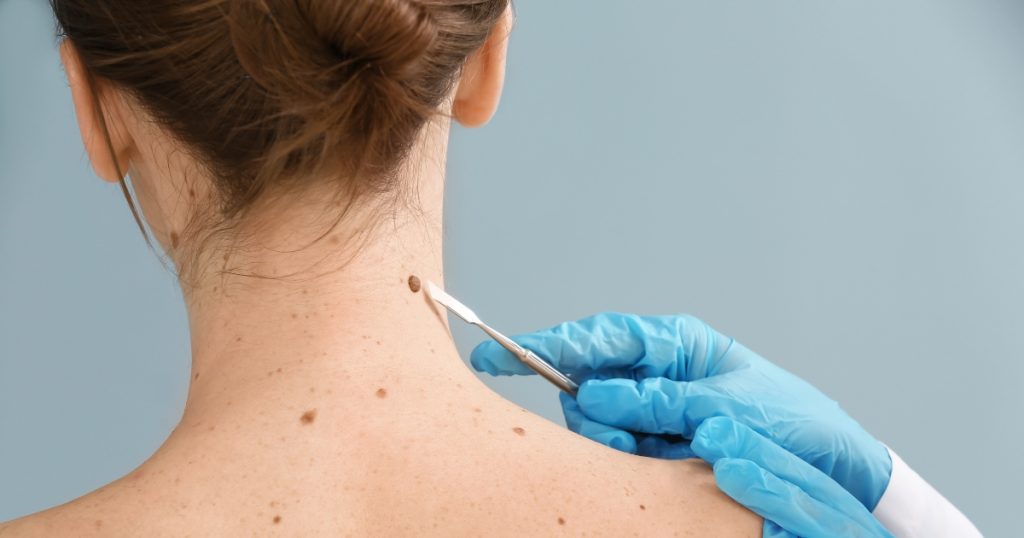Skin tags are visible, tiny pieces of skin. Despite their innocuous nature, their appearance bothers some individuals. This tutorial will describe how skin tags are removed by plastic surgeons. It’s critical to grasp the safe methods for getting rid of them, and this article will help you do just that.
How skin tags are removed?
Skin tags are typically removed through methods such as snipping with medical scissors, freezing (cryotherapy), or burning (cauterisation).
Stay tuned as we tell you more about the methods for removing the skin tags.
Benefits of Skin Tags Treatment
Removing skin tags not only improves the aesthetic appearance of the skin but also prevents potential discomfort and irritation. Some individuals opt for removal due to the tag’s tendency to catch on jewellery or clothing. The risk of infection and inflammation can be reduced with timely treatment.
| Benefit | Outcome |
| Aesthetic Improvement | Smoother skin appearance. |
| Discomfort Prevention | Elimination of snagging risks. |
| Inflammation Reduction | Reduced skin irritation. |
| Confidence Boost | Enhanced self-esteem with clear skin. |
| Medical Monitoring | Ability to examine tags pathologically. |
| Multiplication Prevention | Reduced chances of further tags. |
This table highlights the primary benefits of skin tag treatments, showcasing aesthetic and medical advantages.
Book A Consultation With Dr Shehzadi Tasneem
Top-rated Plastic Surgeon For Skin Tag Removal in Dubai
Installment Plan Available
Common Areas Where Skin Tags Are Found

Skin tags predominantly appear in areas of the body where skin experiences friction. Common sites include the neck, underarms, groin folds, and beneath the breasts. Eyelids are another typical location for these benign growths.
- Neck- Often due to the constant rubbing of collars or chains.
- Underarms- Friction from clothing and skin-to-skin contact makes this area susceptible.
- Groin Folds– The moist environment and friction contribute to tag development.
- Beneath the Breasts– Especially common in women due to bra friction.
- Eyelids- Although small, these tags can be aesthetically bothersome.
- Upper Chest– Occasionally appears due to friction from clothing.
- Back– Rare, but possible, especially along the bra line for women.
See related: Cost of skin tag removal.
The Importance of Professional Assessment Before Removal
Before undergoing any removal process, a thorough evaluation by a healthcare professional is vital. This ensures the growth is a skin tag, not another skin condition. Misdiagnosing and treating can lead to complications or ineffective results.
- Differential Diagnosis– Other growths like moles or warts can be confused with skin tags.
- Prevention of Complications- Professionals can assess the best removal technique for individual cases.
- Understanding the Cause– A thorough assessment can hint at underlying conditions.
- Setting Expectations– Professionals can provide a realistic outcome of the removal process.
- Safety– Ensuring the skin tag isn’t malignant before removal is crucial.
- Guidance on Aftercare– Proper healing post-removal is facilitated by expert advice.
- Assessment of Number– Professionals can efficiently count and plan multiple tags’ removal.
Traditional Surgical Excision of Skin Tags

Surgical excision involves using a scalpel to cut off the skin tag at its base. It’s a straightforward Skin tag removal procedure that offers immediate results. Local anaesthesia is typically administered to numb the area and ensure a pain-free experience.
- Immediate Results- The tag is removed instantly during the procedure.
- Minimal Scarring– Surgical excision leaves little to no scar when done correctly.
- Local Anaesthesia– Ensures the patient feels no pain during the excision.
- Suitable for Larger Tags– Particularly beneficial for removing more significant skin tags.
- Single Session– Most tags are removed in one visit, making it time-efficient.
- Expert Handling- A trained professional ensures a clean and precise cut.
- Histological Examination- The removed tag can be sent for a pathological review if necessary.
Cryotherapy: Using Cold to Remove Skin Tags

Cryotherapy utilises extreme cold, often liquid nitrogen, to freeze off skin tags. The frozen tag then falls off after several days. This non-surgical approach is popular due to its minimal discomfort and effectiveness.
- Non-surgical– Avoids the need for incisions or stitches.
- Quick Procedure– Typically takes only a few minutes per tag.
- Practical– High success rate with most skin tags falling off within 10-14 days.
- Minimal Pain- Some patients report a mild burning or stinging sensation.
- Suitable for Multiple Tags– Can treat several skin tags in one session.
- Low Risk of Scarring– Less invasive than surgical methods, minimising scarring after Skin Tag Removal.
- Post-Treatment Shedding– The frozen tag naturally falls off post-treatment.
Electrocautery: Burning Away the Skin Tag

Electrocautery involves the use of electrical current to burn off the skin tag. The process effectively cauterises the tag, cutting off its blood supply and causing it to fall off. It’s a quick method but may require local anaesthesia.
- Swift Technique– It takes mere seconds to treat each skin tag.
- Cauterisation– Reduces the risk of bleeding during the procedure.
- High Success Rate– Most tags treated with electrocautery fall off quickly.
- Local Anaesthesia– This can numb the area and ensure patient comfort.
- Minimal Scarring– The process leaves little to no residual marks.
- Suitable for Multiple Tags– Efficient for treating several tags in one session.
- Immediate Results– Most skin tags are removed instantly or within a few days.
Laser Treatments for Skin Tag Removal
Laser therapy employs concentrated beams of light to break down skin tags. The laser targets the tag’s pigment, causing it to disintegrate and eventually fall off. This method is especially effective for more petite skin tags and those with a colour contrast to the surrounding skin.
Remember, if you want skin tags gone, it’s best to ask a doctor and choose the right specialist for skin tag removal. They know the proper steps and will guide you through them.
- Precision– Lasers can target the skin tag without affecting the surrounding skin.
- Quick Procedure– Each session is relatively short, often under 30 minutes.
- Minimal Discomfort– The sensation is often likened to a rubber band snap.
- Effective for Small Tags– Particularly beneficial for tiny skin tags.
- No Open Wounds– Reduces the risk of infection post-procedure.
- Multiple Sessions– Some skin tags may require more than one laser treatment.
- Reduction in Hyperpigmentation– Lasers can also address any colour irregularities.
Alternatives to Surgical Procedures for Skin Tag Removal
While surgical procedures are standard and effective, there are alternative methods and home remedies some people consider. However, it’s essential to approach these with caution and under the guidance of a healthcare professional. Effectiveness varies, and some methods may only be suitable for some.
- Tea Tree Oil– Some believe applying this oil can dry the skin tag.
- Apple Cider Vinegar– Its acidic nature is thought to help with tag removal.
- Iodine– Painting the skin tag with iodine is believed to break down its cells.
- String Method– Tying a string around the base of the tag to cut off its blood supply.
- Over-the-Counter Kits– Some kits claim to freeze or dry out skin tags.
- Natural Oils– Oils like castor oil mixed with baking soda are sometimes recommended.
- Herbal Extracts– Certain herbs like bloodroot have been traditionally used, but caution is advised due to potential side effects.
We’ve learned how skin tags are removed by doctors using plastic surgery. It’s a unique process that makes sure the skin stays healthy.
Dr Shehzadi Tasneem Sultan is a top plastic surgeon renowned for her body contouring and facial rejuvenation work. With a solid educational background from Lahore to London, she offers a wide range of procedures like Botox, liposuction, and more. Her main goal? To ensure you feel like the best version of yourself with natural results. Thinking about enhancing your beauty? Book a consultation to learn safe skin tag removal methods recommended by Dr Shehzadi Tasneem and explore how she can help transform your look.












